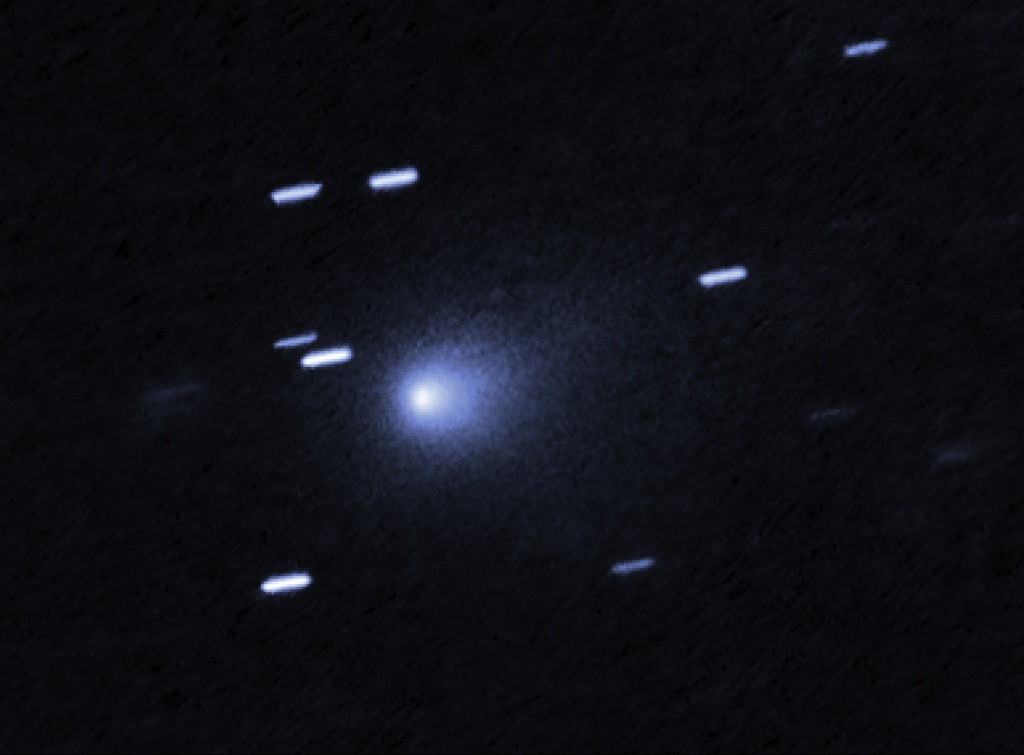How Interstellar Objects Similar to 3I/ATLAS Could Jump-Start Planet Formation Around Infant Stars
Joint Meeting of the Europlanet Science Congress and the American Astronomical Society’s Division for Planetary Science (EPSC-DPS2025) Press Release
Interstellar objects like 3I/ATLAS that have been captured in planet-forming discs around young stars could become the seeds of giant planets, bypassing a hurdle that theoretical models have previously been unable to explain.
Interstellar objects are asteroid- and comet-like bodies that have been ejected from their home system and now wander through interstellar space, occasionally encountering other star systems. Since 2017 astronomers have detected three interstellar objects passing through our Solar System: 1I/’Oumuamua, 2I/Borisov and most recently 3I/ATLAS, discovered in summer 2025.
However, interstellar objects may be more influential than they at first appear to be, says Professor Susanne Pfalzner of Forschungszentrum Jülich in Germany, who presents her new findings on the subject at this week’s EPSC-DPS2025 Joint Meeting in Helsinki.
“Interstellar objects may be able to jump start planet formation, in particular around higher-mass stars,” said Pfalzner.
Planets form in dusty discs around young stars through a process of accretion, which according to theory involves smaller particles come together to form slightly larger objects, and so on until planet-sized bodies have assembled. However, theorists struggle to explain how anything larger than a metre forms through accretion in the hurly-burly of a planet-forming disc around a young star – in computer simulations, boulders either bounce off each other or shatter when they collide rather than sticking together.
Interstellar objects can potentially bypass this problem. Pfalzner’s models show how the dusty planet-forming disc around each young star could gravitationally capture millions of interstellar objects the size of 1I/’Oumuamua, which was estimated to be around 100 metres long.
“Interstellar space would deliver ready-made seeds for the formation of the next generation of planets,” said Pfalzner.
If interstellar objects can act as the seeds of planets, it also solves another mystery. Gas giant planets like Jupiter are rare around the smallest, coolest stars, which astronomers refer to as ‘M dwarfs’. They are more commonly found around more massive stars similar to the Sun. The problem, though, is that planet-forming discs around Sun-like stars have a lifetime of about two million years before dissipating and it’s very challenging to form to form gas giant planets on such a short timescale. However, if captured interstellar objects are present as seeds onto which more material can accrete, it speeds the process of planet formation up and giant planets can form in the lifetime of the disc.
“Higher-mass stars are more efficient in capturing interstellar objects in their discs,” said Pfalzner. “Therefore, interstellar object-seeded planet formation should be more efficient around these stars, providing a fast way to form giant planets. And, their fast formation is exactly what we have observed.”
Pfalzner says that her next steps are to model the success rate of these captured interstellar objects – investigating how many of the millions of captured interstellar objects are able to form planetary bodies, and whether they are captured evenly across a planet-forming disc, or whether they are concentrated in certain areas that could become hotspots for planet-birth.
Further information
EPSC-DPS2025-1927, Interstellar Objects Function as Seeds for Planet Formation Predominantly Around High-Mass Stars
Susanne Pfalzner, https://doi.org/10.5194/epsc-dps2025-1927
Images

Contacts
Professor Susanne Pfalzner
Jülich Supercomputing Center, Forschungszentrum Jülich, Germany
s.pfalzner@fz-juelich.de
EPSC-DPS2025 Press Office
press@europlanet.org
Notes for Editors
About the Joint Meeting of the Europlanet Science Congress and the Division of Planetary Sciences (EPSC-DPS)
The Europlanet Science Congress (EPSC), established in 2006 as the European Planetary Science Congress, is the largest planetary science meeting in Europe. It covers the entire range of planetary sciences, with an extensive mix of talks, workshops and poster sessions, as well as providing a unique space for networking and exchanges of experiences.
EPSC joined forces for the first time with the American Astronomical Society’s Division for Planetary Sciences (DPS) for a joint meeting in Nantes, France, in 2011. This was followed by DPS-EPSC 2016 in Pasadena, EPSC-DPS 2019 in Geneva, and the return to the United States for the DPS-EPSC 2023 meeting in San Antonio. This year will mark the third iteration of a joint European-based meeting. The intent of the joint meetings is not only to connect the European and North American planetary science communities, but also to consolidate two major meetings and motivate planetary scientists from all over the globe to attend. With over 1800 participants joining in person and online, EPSC-DPS2025 is the largest planetary science meeting held to date in Europe. https://www.epsc-dps2025.eu
Follow on social media (Bluesky, X and LinkedIn) with the hashtag #EPSC-DPS2025 for updates on the meeting.
About Europlanet
Europlanet (europlanet.org) is a non-profit association and membership organisation that provides the planetary science community with access to research infrastructure, services and training. The Europlanet Association Sans But Lucratif (AISBL), established in 2023, builds on the heritage of a series of projects funded by the European Commission between 2005 and 2024 (Grant Numbers 871149, 654208, 228319 and RICA-CT-2004-001637) to support the planetary science community in Europe and around the world.
About the DPS
The Division for Planetary Sciences (DPS), founded in 1968, is the largest special-interest Division of the American Astronomical Society (AAS). Members of the DPS study the bodies of our own solar system, from planets and moons to comets and asteroids, and all other solar-system objects and processes. With the discovery that planets exist around other stars, the DPS has expanded its scope to include the study of extrasolar planetary systems as well. The American Astronomical Society (AAS), established in 1899, is the major organization of professional astronomers in North America. The mission of the AAS is to enhance and share humanity’s scientific understanding of the universe as a diverse and inclusive astronomical community, which it achieves through publishing, meeting organization, science advocacy, education and outreach, and training and professional development.

